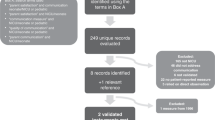Abstract
Objective
Language barriers contribute to suboptimal healthcare delivery. We sought to explore disparities in communication between English and Spanish-speaking parents and their neonatal intensive care unit (NICU) providers.
Study design
We compared English-speaking versus Spanish-speaking parents’ understanding of their infant’s diagnosis through a structured interview.
Results
Spanish-speaking parents were four times (RR 4.0, 95% CI: 1.5, 11.0; p = 0.004) more likely to incorrectly identify their child’s diagnosis than English-speaking parents. Spanish speakers also self-reported lower understanding of NICU interventions. Physicians provided updates to Spanish-speaking parents in their native language only 39% of the time.
Conclusions
Spanish-speaking NICU parents more commonly misunderstood aspects of their child’s care than did English-speaking parents. Providers’ failed to communicate with Spanish-speaking families in their native language the majority of the time. Additional research is needed to assess the barriers to effective communication between NICU providers and Spanish-speaking parents.

Similar content being viewed by others
References
Ennis SR, Rios-Vargas M, Albert NG. The Hispanic Population 2010: 2010 Census Briefs.. Washington, DC: US Census Bureau; 2011.
Martin JA, Hamilton BE, Osterman MJ, Curtin SC, Matthews TJ. Births: final data for 2014. Natl Vital Stat Rep: Cent Dis Control Prev, Natl Cent Health Stat, Natl Vital Stat Syst. 2015;64:1–65.
Colorado Vital Records, Colorado Dept. of Public Health and Environment. 2011; https://www.colorado.gov/pacific/cdphe/vital-statistics-program. Accessed January 2016.
Lorch SA, Wade KC, Bakewell-Sachs S, Medoff-Cooper B, Escobar GJ, Silber JH. Racial differences in the use of respiratory medications in premature infants after discharge from the neonatal intensive care unit. J Pediatr. 2007;151:604–10.
Morris BH, Gard CC, Kennedy K. Rehospitalization of extremely low birth weight (ELBW) infants: are there racial/ethnic disparities? J Perinatol. 2005;25:656–63.
Lamarche-Vadel A, Blondel B, Truffert P, Burguet A, Cambonie G, Selton D, et al. Rehospitalization in infants younger than 29 weeks gestation in the EPIPAGE cohort. Acta Paediatr. 2004;93:1340–5.
Collaco JM, Choi SJ, Riekert KA, Eakin MN, McGrath-Morrow SA, Okelo SO. Socioeconomic factors and outcomes in chronic lung disease of prematurity. Pediatr Pulmonol. 2011;46:709–16.
Cohen AL, Rivara F, Marcuse EK, McPhillips H, Davis R. Are language barriers associated with serious medical events in hospitalized pediatric patients? Pediatrics. 2005;116:575–9.
Enlow E, Herbert SL, Jovel IJ, Lorch SA, Anderson C, Chamberlain LJ. Neonatal intensive care unit to home: the transition from parent and pediatrician perspectives, a prospective cohort study. J Perinatol. 2014;34:761–6.
Miquel-Verges F, Donohue PK, Boss RD. Discharge of infants from NICU to Latino families with limited English proficiency. J Immigr Minor Health. 2011;13:309–14.
Brotanek JM, Seeley CE, Flores G. The importance of cultural competency in general pediatrics. Curr Opin Pediatr. 2008;20:711–8.
Crane JA. Patient comprehension of doctor-patient communication on discharge from the emergency department. J Emerg Med. 1997;15:1–7.
Cohen AL, Christakis DA. Primary language of parent is associated with disparities in pediatric preventive care. J Pediatr. 2006;148:254–8.
Chan KS, Keeler E, Schonlau M, Rosen M, Mangione-Smith R. How do ethnicity and primary language spoken at home affect management practices and outcomes in children and adolescents with asthma? Arch Pediatr Adolesc Med. 2005;159:283–9.
Messiah SE, Asfour L, Arheart KL, Selem SM, Uhlhorn SB, Natale R. Relationship between parent demographic characteristics, perinatal and early childhood behaviors, and body mass index among preschool-age children. J Immigr Minor Health. 2015;17:414–21.
Anand KJ, Sepanski RJ, Giles K, Shah SH, Juarez PD. Pediatric intensive care unit mortality among Latino children before and after a multilevel health care delivery intervention. JAMA Pediatr. 2015;169:383–90.
Wilson CC. Patient safety and healthcare quality: the case for language access. Int J Health Policy Manag. 2013;1:251–3.
Smedley BD, Stith AY, Nelson AR (eds). Institute of Medicine. Unequal treatment: confronting racial and ethnic disparities in healthcare. National Academies Press: Washington, DC, 2003.
Lee JS, Pérez-Stable EJ, Gregorich SE, Crawford MH, Green A, Livaudais-Toman J, Karliner LS. Increased access to professional interpreters in the hospital improves informed consent for patients with limited English proficiency. J Gen Intern Med. 2017;32:863–70.
Price EL, Pérez-Stable EJ, Nickleach D, López M, Karliner LS. Interpreter perspectives of in-person, telephonic, and videoconferencing medical interpretation in clinical encounters. Patient Educ Couns. 2012;87:226–32.
Williams JA. Classroom conversations: opportunities to learn for ESL students in mainstream classrooms. Read Teach. 2001;54:750–7.
Seltz LB, Zimmer L, Ochoa-Nunez L, Rustici M, Bryant L, Fox D. Latino families’ experiences with family-centered rounds at an academic children’s hospital. Acad Pediatr. 2011;11:432–8.
DeCamp LR, Polk S, Chrismer MC, Giusti F, Thompson DA, Sibinga E. Health Care Engagement of Limited English Proficient Latino Families: Lessons Learned from Advisory Board Development. Prog Community Health Partnersh. 2015;9:521.
Acknowledgements
We would like to thank the NICU patients and parents that participated in this study. We also thank Drs. Megan Paulsen and Stephanie Chassen who scored parental identification of the infant’s diagnosis.
Author information
Authors and Affiliations
Corresponding author
Ethics declarations
Conflict of interest
The authors declare that they have no conflict of interest.
Rights and permissions
About this article
Cite this article
Palau, M.A., Meier, M.R., Brinton, J.T. et al. The impact of parental primary language on communication in the neonatal intensive care unit. J Perinatol 39, 307–313 (2019). https://doi.org/10.1038/s41372-018-0295-4
Received:
Revised:
Accepted:
Published:
Issue Date:
DOI: https://doi.org/10.1038/s41372-018-0295-4
- Springer Nature America, Inc.
This article is cited by
-
Increasing in-person medical interpreter utilization in the NICU through a bundle of interventions
Journal of Perinatology (2024)
-
Communication in the neonatal ICU for Spanish speaking parents: a qualitative interview study
BMC Pediatrics (2023)
-
Social Determinants of Health and Health Equity in Pediatric Cardiology Outcomes
Current Treatment Options in Pediatrics (2023)
-
Parental mental health screening in the NICU: a psychosocial team initiative
Journal of Perinatology (2022)
-
Maternal language disparities in neonatal intensive care unit outcomes
Journal of Perinatology (2022)




